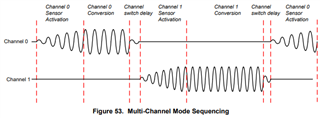Hi Team,
I got following two questions from my customer. Could you tell me how LDC1612 behaves in following case?
1. Address 0x18, STATUS, ERR_CHAN[15:14]
According to the datasheet, ERR_CHAN bits will be as follow when getting something error.
if Ch2 error occurs before Ch1 error is cleared, what happens to the value of this Bits?
b00: Channel 0 is source of flag or error.
b01: Channel 1 is source of flag or error
2. Changing ADDR after power up
What will happen if I change the ADDR Logic(Like high to low) while the device is running and not during shutdown?
Regards,
Takashi Onawa


